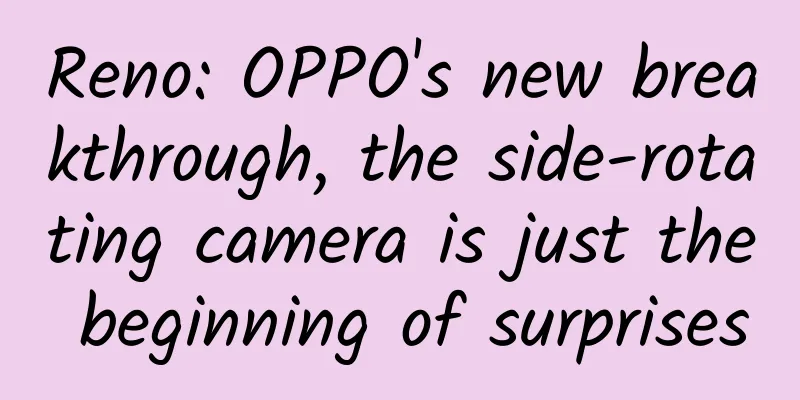|
As an electronic consumer brand dedicated to making hit products, OPPO has always been unique in its product settings and market strategies, attracting countless fans and often achieving staggering sales.
This year, OPPO's strategy has changed again. The new R series products failed to arrive as promised, and the brand new Reno series rushed in. This move really made people a little confused. In today's overall downturn in the mobile phone market, OPPO did not carry forward the R series, which is its advantage, but instead promoted the Reno brand, which is mainly aimed at young people. Why is that?
In fact, after getting this phone, I found that OPPO has indeed changed this year. For this new Reno series defined as "for young people", you can completely regard it as a proactive attack by OPPO in the face of the industry cycle. So, can Reno continue the glory of the R series? Let's take a look together.
Reno continues OPPO's ultimate aesthetic design
OPPO's aesthetic appearance has always been its strong point, otherwise it would not have captured the hearts of so many "factory girls". The model I got my hands on is in mist pink color, and its back cover glass continues the classic matte condensed light design of the R17 Pro. The 3D matte glass is matched with the matte etching process, presenting a light frosted texture on the back cover. It feels smooth and prevents fingerprints from being stained. When I first got my hands on it, I couldn't help but sigh at the delicate feel of this glass.
Reno Mist Pink also adds a light-condensing layer to the 3D curved glass. As the light rotates, the surface of the 3D curved glass has very dynamic light, as light and beautiful as sunlight penetrating through the mist.
The lack of protrusions is a design feature of the Reno series. We first saw this design concept on the Find X, and the Reno series continued it. But unlike the hidden rear camera of the Find X, the Reno camera is completely flat, without any protrusions. To prevent lens wear, a small ceramic protrusion is made under the camera, officially called "O-Dot", to prevent the lens from directly contacting the desktop and avoid lens wear. In addition to the physical protection function, the O-Dot also has a finishing touch on the central axis of the entire mobile phone. At first glance, it looks a bit like the shadow of Sony Ericsson back then.
Why can the Reno series make the camera flat? Is there any black technology? In fact, there is no amazing secret behind it. It’s just that the thickness of the Reno series is a little thicker than the OPPO R series. The standard version is 9mm, and the 10x zoom version is 9.3mm. Of course, the main reason for making the body thicker is to accommodate the lifting structure inside the camera.
What should we do if OPPO, which has always been thin and light, suddenly becomes thicker? OPPO is very smart and has done a lot of work on visual effects. Not only does it use a large arc 3D curved glass on the back, but it also sets a thin line on the waistline of the middle frame of the body (only available in matte pink), making the phone look thinner in both vision and feel.
Back to the front screen, OPPO Reno uses a 6.4-inch FHD true full screen. The screen material is AMOLED. The entire Reno series is equipped with under-screen fingerprint recognition as standard, and uses Corning's 6th generation Gorilla Glass. It supports DCI-P3 color gamut, which changes the oversaturation of the R series in terms of screen appearance, and there will be no obvious fatigue even after watching for a long time.
Due to the true full-screen design, the front camera, front soft light, receiver, and rear flash are all hidden in this new side-rotating lifting structure. There is a hole at the screen bracket for the receiver to guide sound, so you don’t need to use the lifting structure every time you answer a call. To be honest, if you make the camera rise when answering a call, it’s a full sense of ritual, but it will feel redundant after a long time.
According to official information provided by OPPO, this side-rotating lifting structure can be used more than 200,000 times, and will not be damaged even if it is lifted and lowered 100 times a day for five years. In addition, unlike the lifting structure of Find X, there is no rear camera inside, which means that the chance of the lifting structure being awakened during daily use will be greatly reduced. At the same time, the side-rotating design also makes this module take up less space in the body.
ColorOS 6’s new friend Breeno
Before the Reno launch conference, OPPO held a ColorOS 6 launch conference, which shows how big the change is and how much importance OPPO attaches to this system innovation.
ColorOS 6 features a borderless design concept and redraws the interface layout and animation of the system software to be more in line with the display style of the current full-screen era.
To cater to the general trend of full-screen phones, the interface and animation of ColorOS 6 have rounded corners to suit the screen, which is mainly reflected in the animation when opening and closing apps, as well as in the card interface of multitasking.
It is also found that Reno has done a very good job even in very small details. For example, the lock and split-screen buttons are also designed with rounded corners, which shows that the overall beautification is quite complete.
In addition to the beautiful new interface, ColorOS 6 also brings us a new friend - Breeno, which can be regarded as a personal assistant, assisting you in your daily life at all times and enriching the humanized design of ColorOS.
First of all, the original negative one screen is replaced with Breeno Quick View, which you can think of as a tool area. In addition to the shortcut functions of the original negative one screen, two new permanent services, weather and calendar, are added. Now you can also customize and add new services in the upper right corner, covering travel, life, entertainment, shopping, cars and other life services.
Travel services are probably the ones we use most frequently. You can complete your personal information and preferences in Settings - Breeno, so that Breeno Quick View can make travel suggestions based on your information. You can navigate directly home with one click, eliminating the need to switch back and forth between multiple apps. It is very convenient.
OPPO also has a function similar to the Big Bang function of the Hammer phone. Relying on the Breeno screen recognition function, you can quickly get the corresponding information by pressing the text or image with your thumb.
In addition to waking up Breeno by pressing your thumb, if you copy text content, Breeno will determine your next action and make intelligent recommendations. For example, copying the "Taobao password" will directly pop up the Taobao shortcut button.
Breeno has developed a driving mode for car owners. After turning on Breeno driving, a Breeno wake-up voice button will be added to the screen for quick operation during driving. Of course, if you don’t want to be disturbed while driving, just like the game mode, you can set the driving do not disturb function in Breeno, directly set the rejection reply content, or intelligently broadcast information, etc. This function is really important for safe driving.
It is worth mentioning that this time ColorOS 6 has upgraded Game Boost 2.0, which comprehensively optimizes the gaming experience. In addition to dynamically adjusting the system resource allocation, it also supports performance optimization of touch sensitivity and pre-targeted processing of possible freezes. Overall, the game fluency is better than before.
According to our actual tests, Reno maintained a frame rate of over 58 in Honor of Kings, and there was no obvious lag in PUBG Mobile. We believe that Reno will perform better on the 855 version.
48MP dual-camera with superb resolution
The main rear camera of Reno is a 48-megapixel IMX586 with an aperture of F1.7. The default 12-megapixel four-in-one mode has a single pixel of 1.6μm. You can manually select 48-megapixel full-pixel output in the settings. At this time, the area of a single pixel is 0.8μm. The secondary camera is a 5-megapixel depth-of-field camera and does not participate in imaging. The front camera is a 16-megapixel IMX471 with an aperture of F2.0 and a single pixel area of 1μm. The front camera is also equipped with a soft light.
The overall configuration is in line with the positioning of the standard version. It is a pity that there is no 2x optical zoom, which is a step backward compared to R17. However, Reno still retains the 2x button on the viewfinder interface. When taking pictures, the digital zoom will be performed in four-in-one pixel mode, and then interpolated to 12 million pixels.
According to the test, whether it is the 12-megapixel four-in-one digital crop or the full-pixel 48-megapixel manual crop, the difference in details is not big, but because the white balance will be recalculated when framing in the 12-megapixel mode, the color of the photo will change slightly.
Normal daytime street photography and drug testing are no problem, the 48-megapixel IMX586 provides sufficient support, supports AI scene recognition, and can adjust colors according to the object you are shooting.
Night Scene 2.0 is a major feature of the Reno camera. It is basically similar to the night scene mode of mainstream flagships. It requires 4 seconds of handheld shooting. It mainly suppresses highlights and enhances dark areas to improve the dynamic range of night scenes. It can be regarded as super HDR. Night Scene 2.0 outputs a total of 12 million pixels and provides 2x digital zoom.
From the sample photos, we can see that Reno can effectively suppress the highlight part and control the noise relatively well, but the resolution of the film is slightly insufficient and the improvement of dark details is also limited. Overall, Reno's night scene mode has a good intuitive feeling, but it cannot withstand zooming in and examining. Unfortunately, the night scene function needs to be turned on manually and cannot be automatically turned on through AI scene recognition.
VOOC 3.0 & NFC
The battery capacity of the Reno standard version is 3765 mAh, which is an improvement over the R17 3500 mAh. According to a 5-hour battery life test, the remaining power is 58, which is enough for normal use for 1.5 days. The actual charging time from 0 to 100% is 80 minutes. As a representative of low-voltage fast charging, VOOC 3.0 is generally not much different from VOOC 2.0. The upgrade of 3.0 is mainly in software algorithms, using VFC fast charging algorithm. The official said that it can improve charging efficiency and shorten the total time by 23.8%, but the subjective feeling is not much different from 2.0, which is a small upgrade that is not painful.
OPPO has equipped the Reno series with multi-function NFC as standard, which can support access card simulation, bus cards, OPPO Pay, etc. It can be said that it is on par with the industry's flagship mobile phones. According to our actual experience, the bus card supports card swiping operations with the screen off and no network. Currently, the bus card supports the Beijing-Tianjin-Hebei Joint Intercommunication Card, Lingnan Pass-Yangcheng Pass, Jilin Pass, Jiangsu Transportation Card-Suzhou, Shenzhen Pass, Guangxi Transportation Card, Harbin City Pass, Wuhan Pass, Hefei Pass, Green City Pass, Hainan Pass, Xiamen e-Pass, Qindao Pass, Ningbo Yongcheng Pass, etc. In terms of NFC function, Reno is on par with flagship phones.
Summarize:
The Reno standard version can be seen as a simplified version of the Reno 10x zoom version, lacking the 10x hybrid zoom, ultra-wide-angle camera, Snapdragon 855 processor, linear motor, and dual speakers. But at the same time, we have to see what OPPO has left us, including multi-function NFC, under-screen fingerprint recognition, IMX586, headphone jack, Type-C, etc. In fact, OPPO did not deliberately cut any configuration, and most of the flagship configurations were retained. In contrast, the products of a friendly competitor this year have been "stuck" in the main camera, fast charging, processor, etc., which further highlights the sincerity of Reno in many basic configurations.
The R series is OPPO's hit series. You can see it in subway stations, bus stops, variety shows and other occasions. It sells tens of millions of units a year and is synonymous with hit products. Now in the fiercely competitive year of 2019, OPPO's brand stratification is on the agenda, and Reno is born. From the comprehensive quality it shows, it can be seen as OPPO's attack in a new market. In fact, in OPPO's plan, Reno is a market segment king that will accurately hit the user's psychological expectations. This can be seen from its decisive stocking of 2 million units. It can be foreseen that in the market targeting young people, the comprehensive quality and proven Reno will surely achieve great success.
As a winner of Toutiao's Qingyun Plan and Baijiahao's Bai+ Plan, the 2019 Baidu Digital Author of the Year, the Baijiahao's Most Popular Author in the Technology Field, the 2019 Sogou Technology and Culture Author, and the 2021 Baijiahao Quarterly Influential Creator, he has won many awards, including the 2013 Sohu Best Industry Media Person, the 2015 China New Media Entrepreneurship Competition Beijing Third Place, the 2015 Guangmang Experience Award, the 2015 China New Media Entrepreneurship Competition Finals Third Place, and the 2018 Baidu Dynamic Annual Powerful Celebrity. |










